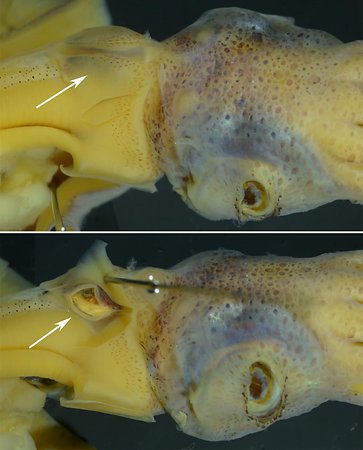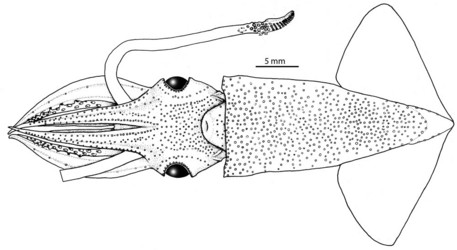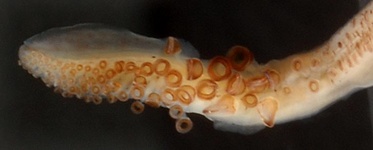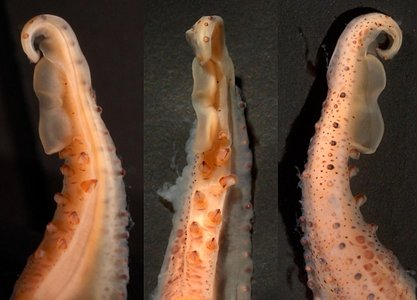Abralia similis
Kotaro TsuchiyaIntroduction
A. similis is a small-sized species, less than 35mm DML, and is widely distributed in the equatorial to subtropical Pacific. It is characterized by a reddish or purplish brown body color, a small number of club hooks (2) and a bilobed hectocotylus flap.
Brief diagnosis:
An Abralia (Pygmabralia) found in the Pacific Ocean and with ...
- scattered integumental photophores on ventral mantle and head.
- proximal, bilobed ventral membrane of hectocotylus located near midline of oral surface of arm.
Characteristics
- Tentacle clubs
- Two hooks on ventral side.
- Two rows of large suckers on dorsal side of manus.
- Hectocotylus
- Right ventral arm of male hectocotylized.
- Hectocotylus with two different sized flaps: Large proximal, ventral bilobed flap and small distal, dorsal flap.
- Eye Photophores
- Five silvery organs.
- Five silvery organs.
- Integumental Photophores
- Ventral mantle and head with scattered arrangement of integumental organs.
- Ventral mantle and head with scattered arrangement of integumental organs.
- Epidermis
- Thick, fragile, and gelatinous.
- Thick, fragile, and gelatinous.
- Mantle apex ("tail")
- short, extends just beyond conus of gladius.
- short, extends just beyond conus of gladius.
- Reproductive structures
- Spermatangia receptacles: The receptacles are located within the dorsal-collar pocket but instead of being attached to the walls of the pocket, they lie within an additional pocket, called the "Dorsal-Collar Pouch" which has its own, walls that are free from those of the dorsal-collar pocket.
 Click on an image to view larger version & data in a new window
Click on an image to view larger version & data in a new window
Figure. Dorso-lateral views of the head and collar region, with the mantle removed, of A. similis, female, 26 mm ML. Top - The collar is intact and seen through the collar wall is a dark, swollen structure (arrow) where the spermatangia lie. Bottom - The collar has been cut and pinned dorsallyrevealing the open pouch (arrow) beneath that is filled with spermatangia.
- Spermatangia receptacles: The receptacles are located within the dorsal-collar pocket but instead of being attached to the walls of the pocket, they lie within an additional pocket, called the "Dorsal-Collar Pouch" which has its own, walls that are free from those of the dorsal-collar pocket.
Comments
A. similis closely resembles the Atlantic A. redfieldi in the eye photophore, epidermis, club and hectocotylus morphologies.
Distribution
Geographical distribution
This species was first described from the Northwest Pacific. It is the most widely distributed member of the genus Abralia. It has also been recorded from Papua New Guinea (Rancurel, 1970), south of Tonga (Riddell, 1985) and the tropical West Pacific (Burgess, 1992). In the Northwest Pacific, this species occurs south of Kuroshio Current axis.References
Burgess, L.A. 1991. Squids of the Genus Abralia (Cephalopoda) from the Central Equatorial Pacific with a Description of Abralia heminuchalis, New Species. Bulletin of Marine Science, 49(1-2)(1991):113-136. [Published 29 January 1992]
Hidaka, K. and T. Kubodera. 2000. Squids of the genus Abralia (Cephalopoda: Enoploteuthidae) from the western tropical Pacific with a description of Abralia omiae, a new species. Bulletin of Marine Science, 66(2):417-443.
Rancurel, P. 1970. Les contenus stomacaux díAlepisaurus ferox dans le Sud-ouest Pacifique (cephalopodes). Cah. O.R.S.T.O.M., ser. Oceanogr., 8: 3-87.
Riddell, D.J. 1985. The Enoploteuthidae (Cephalopoda: Oegopsida) of the New Zealand Region. Fisheries Research Bulletin (N.Z. Ministry of Agriculture & Fisheries), 27:1-52.
Okutani, T., and K. Tsuchiya. 1987. Abralia similis, a New Enoploteuthid Squid from the Northwest Pacific (Cephalopoda, Oegopsida). Bulletin of the National Science Museum, Tokyo, (series A)13(4):141-150.
Title Illustrations

About This Page

Tokyo University of Fisheries, Tokyo, Japan
Page copyright © 2018
All Rights Reserved.
- Content changed 21 January 2014
Citing this page:
Tsuchiya, Kotaro. 2014. Abralia similis . Version 21 January 2014 (under construction). http://tolweb.org/Abralia_similis/19662/2014.01.21 in The Tree of Life Web Project, http://tolweb.org/











 Go to quick links
Go to quick search
Go to navigation for this section of the ToL site
Go to detailed links for the ToL site
Go to quick links
Go to quick search
Go to navigation for this section of the ToL site
Go to detailed links for the ToL site